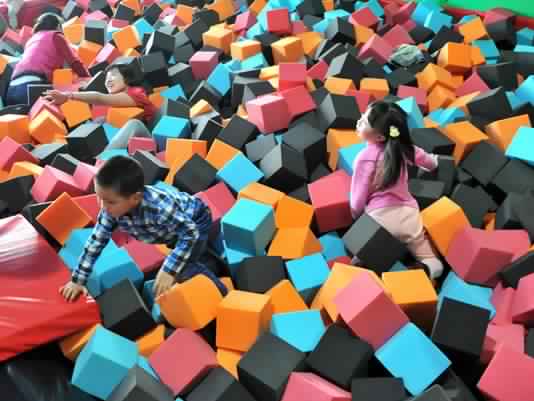As trampoline parks spring up across the United States, injuries to kids have jumped, too, a new study finds.
Using reports from a sample of U.S. hospitals, researchers at Connecticut Children’s Medical Center estimated that visits to emergency departments for injuries from trampoline parks rose from 581 visits in 2010 to 6,932 in 2014. Their study, which will be published online today and in the September issue of the journal Pediatrics, calls trampoline park injuries “an emerging concern.”
Pediatrics is published by the American Academy of Pediatrics, which has previously advised against recreational trampoline use.
Trampoline parks, indoor facilities where guests pay to bounce on trampolines, have popped up around the country in recent years — including four opening in the Pittsburgh area. The industry has grown from 25 parks in the United States in 2010 to more than 350 parks in 2014, according to the International Association of Trampoline Parks, a trade group based in Hershey, Pa. The association estimates that over the past year more than 50 million people visited trampoline parks in North America.
The researchers behind the new study estimated that an average of 91,750 visits to U.S. emergency departments occurred each year from 2010 through 2014 for injuries received from any kind of trampoline, with the majority of injuries occurring at homes. When they compared the kinds of injuries jumpers received at trampoline parks to those received on home trampolines, they found that the trampoline park injuries were more likely to require hospital admission, a measure of the seriousness of the damage, though they were less likely to involve head injuries. Trampoline park injuries often involved the lower part of the body.
Jumpers at the parks were injured when they landed wrong, came into contact with other jumpers, attempted flips, fell off trampolines and landed on the frame or springs, the data showed.
Kathryn Kasmire, the study’s lead author and a fellow in pediatric emergency medicine at Connecticut Children’s Medical Center, said the idea for the inquiry came from experience in the emergency room, which she said is close to several trampoline parks.
“We were seeing a lot of injuries from kids coming from the trampoline park,” she said. “We were concerned with how serious some of the injuries were.”
Ray Pitetti, associate chief of the division of pediatric emergency medicine at Children’s Hospital of Pittsburgh of UPMC, said the study’s data coincides with injuries he has been seeing in the emergency department among patrons of trampoline parks: sprains or strains, but also broken arms and legs and concussions.
“I’ve seen a number of kids who have been pretty seriously injured from trampoline parks,” he said.
After doing the study, Dr. Kasmire said she would probably recommend against going to trampoline parks, but that if people choose to go, they should go at a less-crowded time and avoid doing flips and that parents should supervise their children.
In Pennsylvania, the state Department of Agriculture regulates and inspects trampoline parks, said Logan Hall, a spokesman.
Altimate Air trampoline park in North Versailles follows guidelines put forward by the International Association of Trampoline Parks and posts safety rules — such as one jumper per trampoline, no double flips, no interfering with another jumper’s bouncing — inside the facility, said Phil Zacheretti, president of Pheonix Trampoline Park Management, which manages the park
“We’re concerned about every possible injury, from a bumped elbow to the worst,” Mr. Zacheretti said. “So every safety precaution is taken.”
Ralph Park, an owner of Flight Trampoline Park in Bridgeville said the park takes a number of steps to reduce risks to jumpers, including training employees about rules to enforce, requiring patrons to watch a video, posting rules and separating jumpers who are shorter than 46 inches from taller guests.
“It’s just common sense things,” he said. “If you follow the rules and pay attention to what you’re doing, you can have a great time.”
The region also has Sky Zone parks in Monroeville and Leetsdale.
In a statement, the International Association of Trampoline Parks said it welcomes studies like the new report, adding: “Such studies provide a deeper understanding of safety issues and provide data on our sport allowing us to better educate parents, jumpers and parks so all can fully enjoy indoor trampoline park facilities.”
Dr. Pitetti of Children’s Hospital said he does allow his children to go to the parks, and he encouraged parents to supervise young jumpers.
At a Sky Zone park in Mechanicsburg, Cumberland County, one evening last week, Angela Landi waited as her three children jumped on the trampolines. She said she felt more comfortable about the safety of the activity because her youngest child is now 15.
“I feel a little safer with that,” she said. “I don’t know that I would bring them when they were younger.”
Ellie Stache, whose 6-year-old son was at the park for a birthday party, noted that there are rules at the park and staff watching the jumpers.
“I think it’s a good thing kids are getting out there and they’re being more active,” she said. “But of course there are going to be injuries.”
Muriel M. Delossantos














AND WHY do we think there are so many injuries here…. I’m a retired
K-12 PE teacher (hubby taught science and art)????? Don’t think too hard, BUT the key to this issue is that there desperately NEED to be
MORE RESPONSIBLE (age 20 up. trained in CPR/ALRS/FIRST AIDE/TEACHING
BASIC TRAMPOLINE SKILLS) mature ADULTS ON DUTY HERE. Organize it just
LIKE A SOCCER PROGRAM….Every week, a “sponsor,” takes AT LEAST 1 hr.
per wk., MORE if POSSIBLE. (Get the Grandma’s and Grandpas, Uncles and
Aunts, etc involved.) Get the SURROUNDINGS NEIGHBORS INVOLVED, and
YOUR PROGRAM’S going to BE A SAFE WINNER.